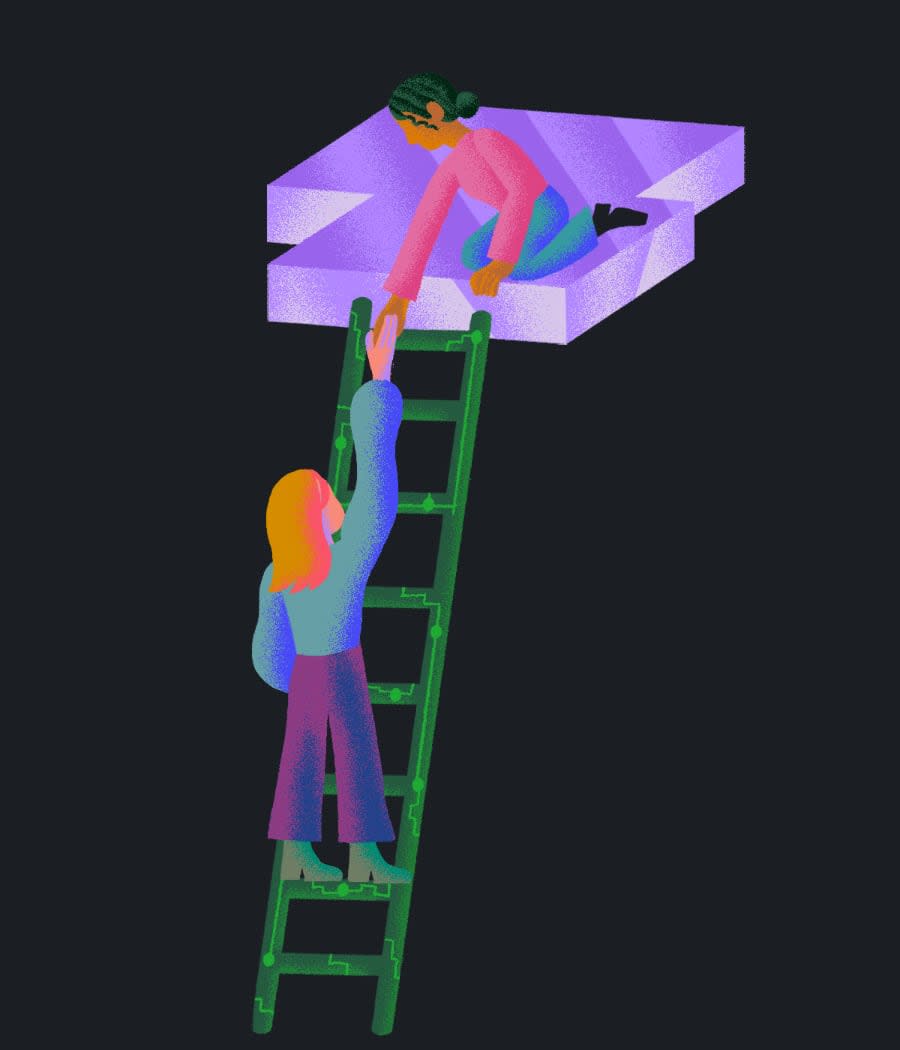Angie Brown started her career as a software engineer at The Home Depot in 1998—just two years before the company’s first ecommerce site launched. Over the next two decades, she rose through the ranks to become Vice President of Technology.
Brown’s skyrocketing career was hard-won, and she had numerous women that modeled leadership for her at The Home Depot. There were women in many of the top leadership roles at the company and employee resource groups dedicated to supporting women. “If I had challenges it was mostly in my own confidence,” she says. “Gender wasn't really something we discussed back then. Women in STEM wasn’t really a big topic of conversation.”
Not all women can relate to Brown’s experience. “I have seen instances where only the men in the company get promoted,” says Mariatta Wijaya, a Python core developer and co-organizer of PyLadies Vancouver. “Or where companies decide to hire more women, but what they really mean is that they want to hire women for junior roles, forgetting that women are qualified for higher-level roles too.” Women represent just 26% of the computing workforce and 11% of senior leadership at tech companies, according to a 2018 report titled “Rebooting representation” that led to the creation of the Reboot Representation Tech Coalition.
Brown’s example shows it doesn’t have to be this way. It’s possible to build inclusive teams that give women opportunities and value their contributions. Now is a critical moment to do so. Since the beginning of the COVID-19 pandemic in the US, women’s workforce participation rate has dropped faster than men’s, according to the Bureau of Labor Statistics. In January, women’s participation in the workforce dropped to 57%, the lowest rate since 1988, the National Women’s Law Center points out.
Bringing more women into technology and—crucially—retaining and promoting them wouldn’t just be a win for equity. Companies expect demand for IT and programming skills to increase by as much as 90% over the next 15 years, according to a McKinsey report. More women in tech could help prevent a shortage of developers and other technical workers. A separate report, meanwhile, found that companies with women in executive leadership were “21% more likely to outperform on profitability and 27% more likely to have superior value creation.” Startups, open source projects, and large organizations alike can benefit from cultivating teams with diverse perspectives.
As disruptive as the pandemic has been, it’s forced companies to rethink everything—from hiring and training to where and what hours their employees work. There has never been a better time to remake the workplace.

Start at the top
It’s up to a company’s leadership to show that diversity and inclusion is a priority. When leaders take the initiative to include women, it sets an important example for others in the organization or community. For example, Python creator Guido van Rossum personally mentored Wijaya and encouraged her to get involved in the language’s core development. “That sort of positive influence from leaders is one of the key things that helps,” she says.
More women in high-level positions means more role models and more mentorship. It creates a virtuous cycle. “As long as I've been at The Home Depot we have had women in the highest levels of leadership cultivating a support organization for people to feel empowered and have a sense of community,” Brown says. For example, Carol Tomé, the company’s former CFO, founded the company’s employee resource group (ERG) for women in leadership, the Velvet Hammers, in the 1990s.
The highest levels of leadership need to empower the teams recruiting and retaining women and other under-represented groups to make organizational changes. Reboot Representation CEO Dwana Franklin-Davis says that lack of clear ownership is a common problem for corporate inclusion efforts. She recommends companies appoint a senior executive to manage diversity strategies at the intersection of race and gender. Organizations need programs explicitly designed for women of color, she explains. Otherwise, these groups tend to remain underrepresented. Because they face some of the biggest workplace challenges, addressing inclusivity for women of color can have positive spill-over effects for all women and BIPOC communities.
As Safia Abdalla, a maintainer of the interactive Juptyer Notebook desktop platform nteract, put it: “When women and other underrepresented individuals see a woman of color as nteract’s maintainer, it enforces a certain level of trust. It motivates you to contribute more than if you didn’t see someone who looked like you, or that you could relate to, in a position of power.”

Invest internally
Keep in mind that starting at the top doesn’t mean inclusivity will seep into every level of a workplace by default. Achia Nila, founder of the Dhaka, Bangladesh-based digital agency and code school Women in Digital, says that she landed her first programming job because the owner of the company was supportive of women in tech. But despite his support, she still found herself among coworkers who weren’t so welcoming.
Nila’s experience highlights why recruiting women isn’t enough. A recent report published by Accenture and Girls Who Code found that despite 80% of women surveyed reporting “loving their work,” half of all women who take a job in tech leave the field by age 35, citing non-inclusive workplaces as the main reason. Women leave other fields at a rate of only about 20%.
Nila realized she had to fight for other women in the industry in Bangladesh. And in 2013, she started her own company to train and employ women in technical roles in South Asia.
Hiring gets women in the door but clear and inclusive policy—from family leave to unconscious bias training—gets them to stay.
One of the most fundamental improvements organizations can make is to offer childcare. The lack of childcare is a leading reason that mothers everywhere drop out of the workforce, especially during the pandemic. A poll by Fairleigh Dickinson University last year found that 14% of parents of young children in New Jersey quit their jobs in order to manage childcare. Women were six times as impacted as men. “We need support,” Nila says. “For example, companies should offer childcare on-site.”
Franklin-Davis also encourages companies to lobby for policies to improve access to childcare to all families.
Childcare is only one piece of that puzzle. Women need mentorship and support navigating the opportunities within an organization. ERGs can play a critical role in providing this support to women and people from other underrepresented groups. Franklin-Davis was a founding member of the Black employee resource group at Mastercard and cites her experience as part of the group’s leadership as an important element of her career development.
ERGs require buy-in and support and cannot just be founded and abandoned. “ERGs should be funded by the organization, with a leadership structure, goals and metrics, and executive sponsorship,” she says. They’re not just a springboard for diversity initiatives but can have a measurable impact on an organization’s business. For example, if a company is planning to expand into a new market, ERGs can be an internal resource for consulting.
It’s important to remember, Franklin-Davis, notes, that ERGs aren’t in and of themselves a diversity program. They’re just a support aspect.
Women also need opportunities for career development. For example, organizations can reserve time “on the clock” for women and other under-represented groups to contribute to open source. Organizations will benefit from more perspectives shaping their public projects. And employees will get the chance to grow their skills. That’s especially important since women are more likely to have caregiving responsibilities, such as childcare or caring for other family members, which can limit the amount of time they have to contribute to open source projects on a volunteer basis. That’s even more true amidst the pandemic as childcare costs skyrocket.
Meanwhile, individual employees can also do their part. “As an individual contributor, don’t just shoot down your peers’ ideas—explore them. Be active about seeking out different ideas and perspectives,” Brown says. “And as simple as it sounds, it’s incredibly important that you thank and recognize the good work of your peers.”

Rethink the pipeline
Engineering teams have long bemoaned the lack of qualified women available to hire. This is often referred to as the “pipeline problem.”
Reboot Representation found that women are the recipients of only 19% of degrees in computer and information science degrees. Reversing that trend will be key to improving equity in tech. “There aren’t many women in my computer science program,” says Shikha Bhat, curator of the Women in Tech resource directory and a computer science student at the Birla Institute of Technology and Science in Goa, India. “The lack of women role models as a very important factor.” However, attrition rates show industry can’t place all the blame on the pipeline. If more women were supported in their career growth, there would be more mentors and role models for women and girls, and thus more encouragement.
The pipeline is important and programming classes and workshops for grade school and high school age girls are important because they can help students discover a passion early on. Programs like Black Girls Code, which introduces teens and pre-teens of color to STEM, are crucial for this.
Encouraging more women to pursue computing degrees will also require decision-makers to question many of their assumptions about the pipeline. “Many companies worry that once girls reach high school or college, it is difficult, if not impossible, to build their interest in tech,” Reboot Representation’s report notes. “However, research shows that it is never too late—there are effective ways to create on-ramps for women and girls to tech at later life stages, even in higher education.” In other words, the stereotype that all great programmers start when they’re very young is unfounded.
Brown didn’t get much exposure to programming in high school, so she gravitated towards other STEM-related courses. “I really loved math and I really loved business, so I started out as an accounting major in college.” It wasn’t until college that she discovered her passion for blending business with programming and soon switched her major to management of information systems. Similarly, Applitools Senior Director of Developer Relations, Angie Jones, started college as a business major. “I didn’t know software engineering was a thing,” she said. It wasn’t until she took her first programming class that she decided to switch majors to computer science and pursue a career in tech.
While donating funds to programs that encourage high school or younger girls to pursue an education in STEM helps, it’s equally important to invest in programs aimed at women in college or pursuing mid-career changes. Girls Who Code, for example, offers a program called “College Loops” for university and college students that includes networking, support, and courses such as introductions to open source.

Now is the time
One bright spot amidst the pandemic is the explosion of opportunities in remote learning and remote work.
The Ada Developer Academy is a Seattle-based organization dedicated to teaching women, LGBTQIA+, and other underrepresented groups to code. “We actively resisted the idea of teaching remotely,” Ada Developer Academy CEO Lauren Sato says. The pandemic, however, forced the organization to shift its classes online.
“It’s definitely made a positive difference,” she says. “We had students in the last cohort who would have had to drop out to take care of family members out of town. They were able to stick with the program.”
It also made the program more accessible to people in places that haven't traditionally been thought of as tech hubs. Meanwhile, the option to take remote internships has expanded employment opportunities for the Academy’s graduates. The organization will keep offering both remote and in-person classes once the pandemic is over.
The world is only just starting to understand the benefits—and drawbacks—of remote work and distance learning. The 2020 State of the Octoverse found that developers have been more productive since shelter-in-place orders took effect last year. But whether this is a burst of energy or a sign of faltering work-life balance is unclear. Further, broadband access still isn’t universal. There are parts of the world—including the US—that still lack reliable, affordable connections.
Meanwhile, the pandemic is changing work culture in ways that extend beyond remote work. “Many companies, Home Depot included, are recognizing that 2020 was a year like no other,” Brown says. “We're shifting away from traditional performance metrics and adjusting working norms to be more accomodating and ultimately more empathetic to people who wear multiple hats beyond their day jobs. I think increased understanding is important.”
The COVID-19 era is a time of enormous uncertainty. But it’s also wiped clean many of the deeply ingrained certainties of office life. It’s the perfect time to question assumptions, experiment with new ways of working, and start making strides towaworkplace inclusion. Is your team seizing the opportunity?



